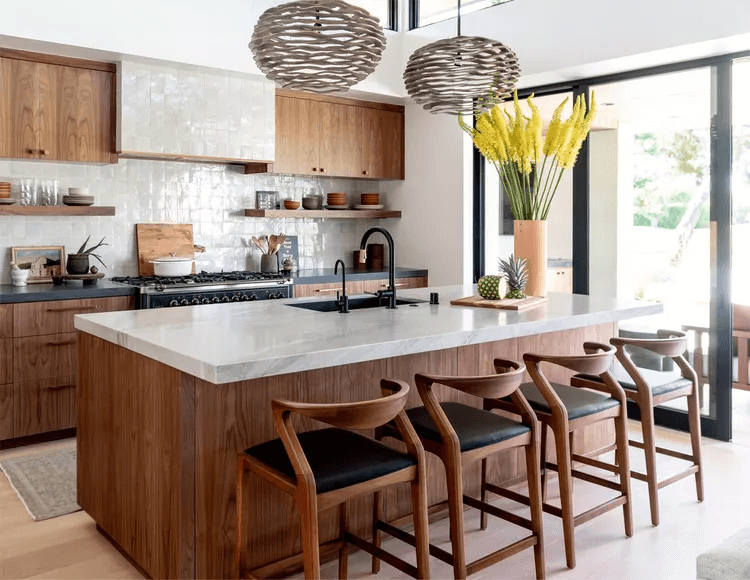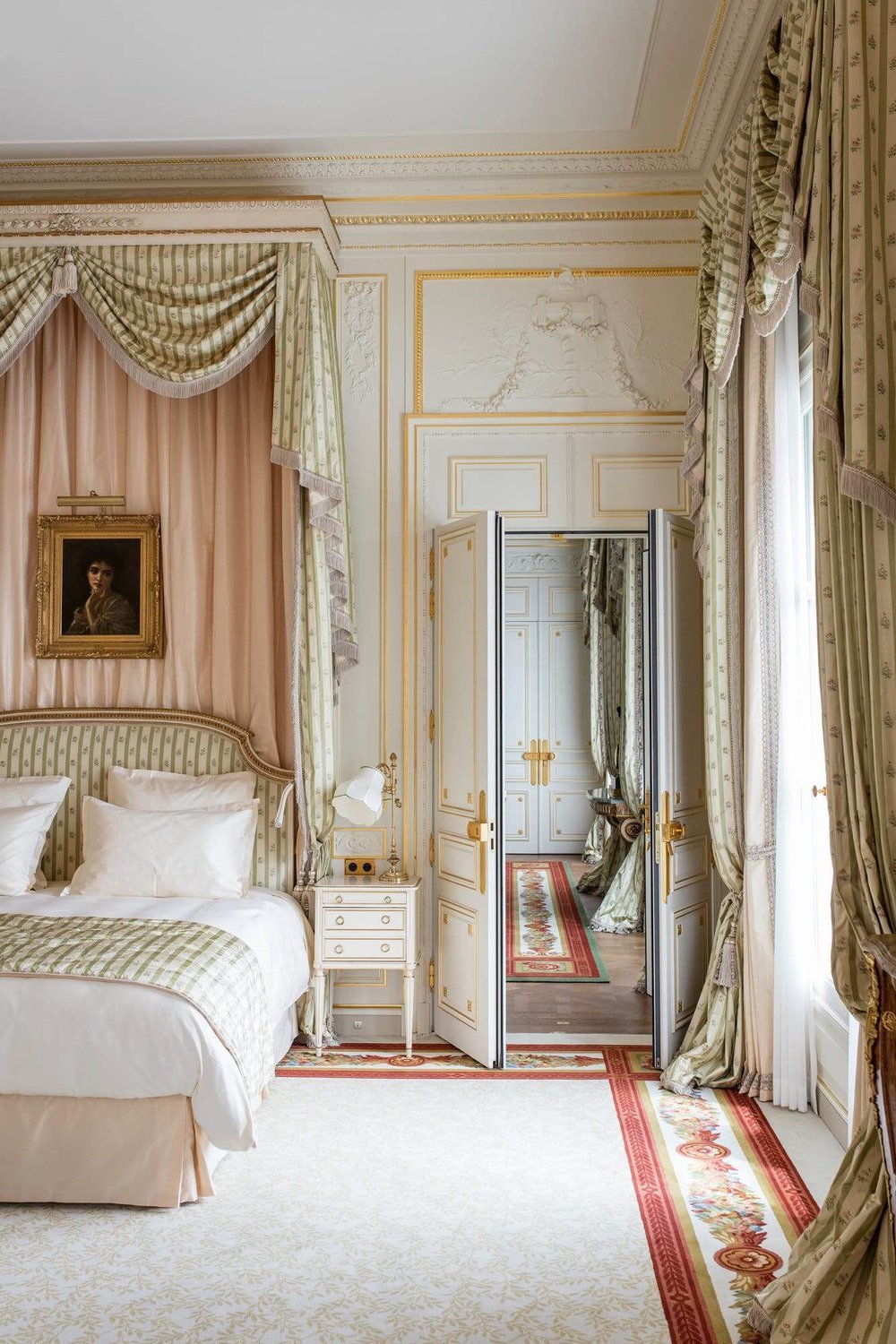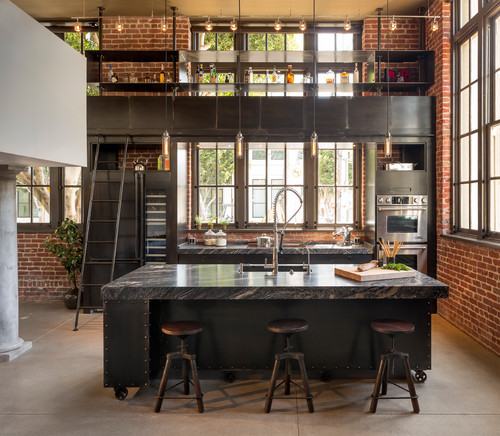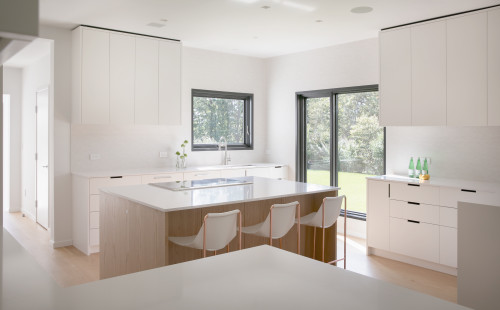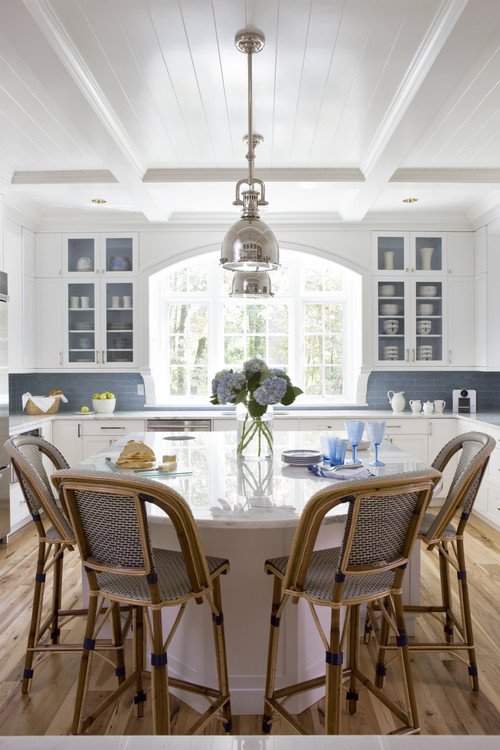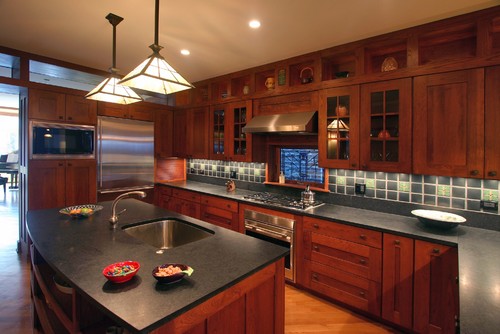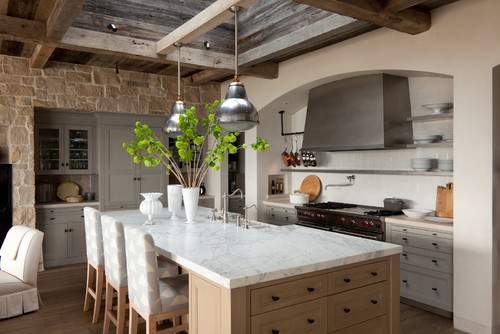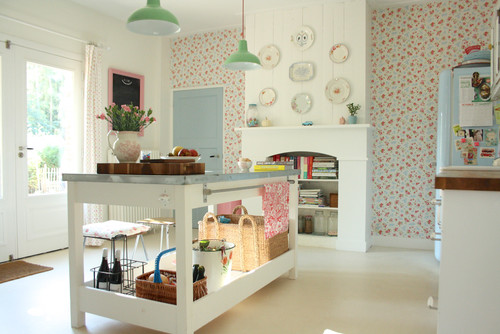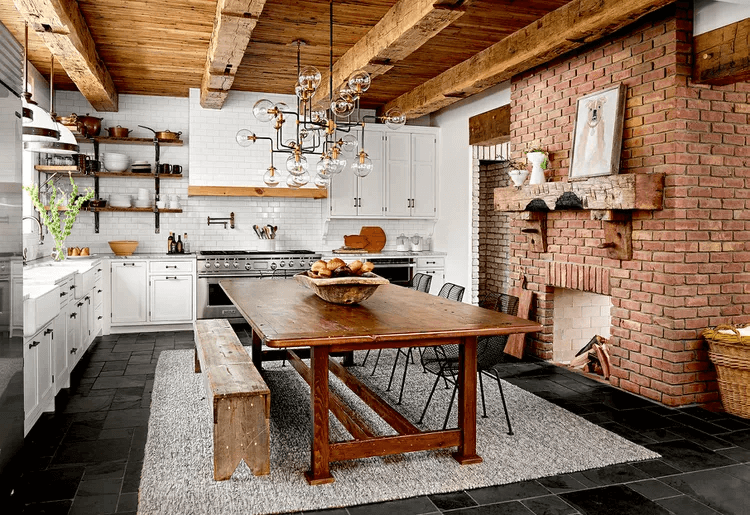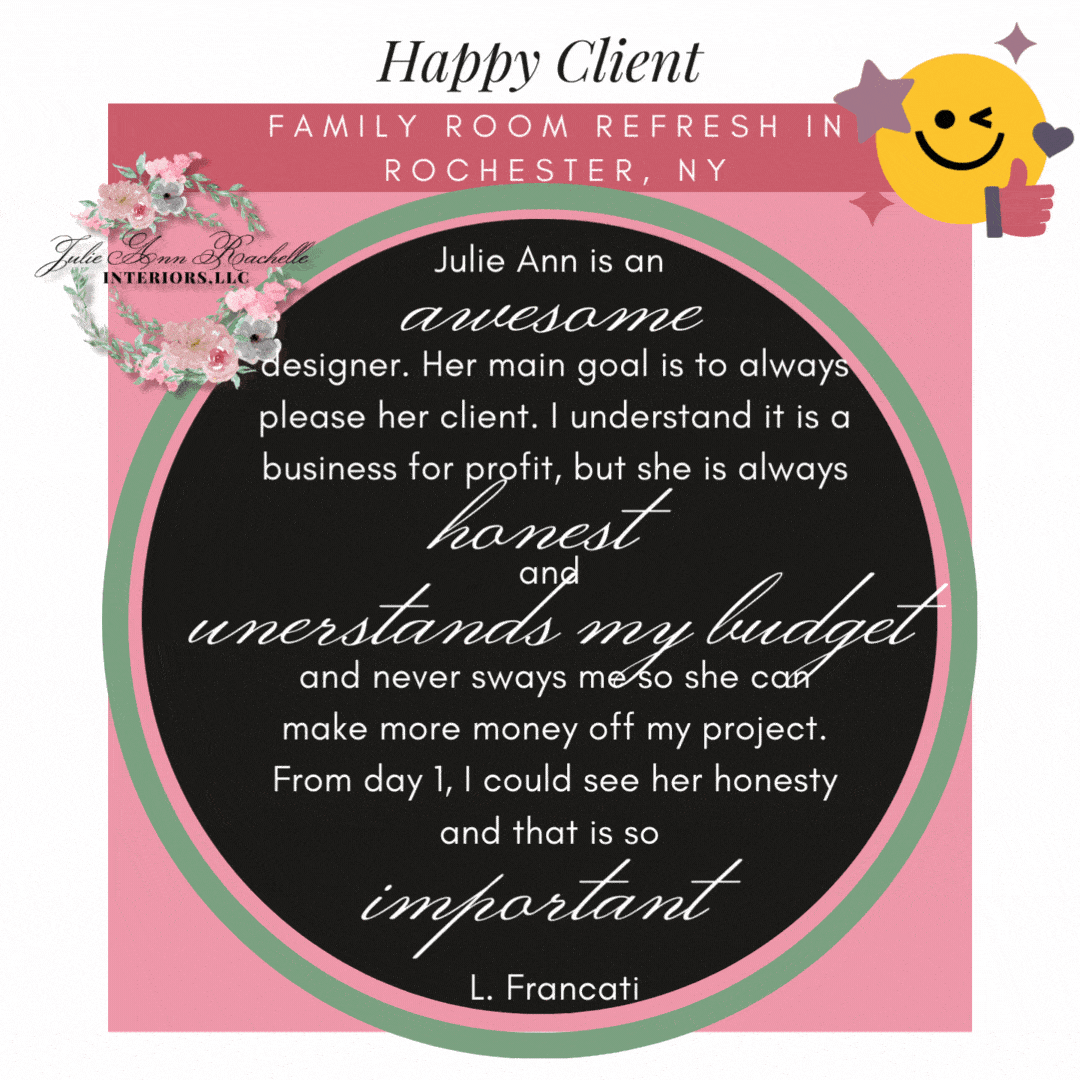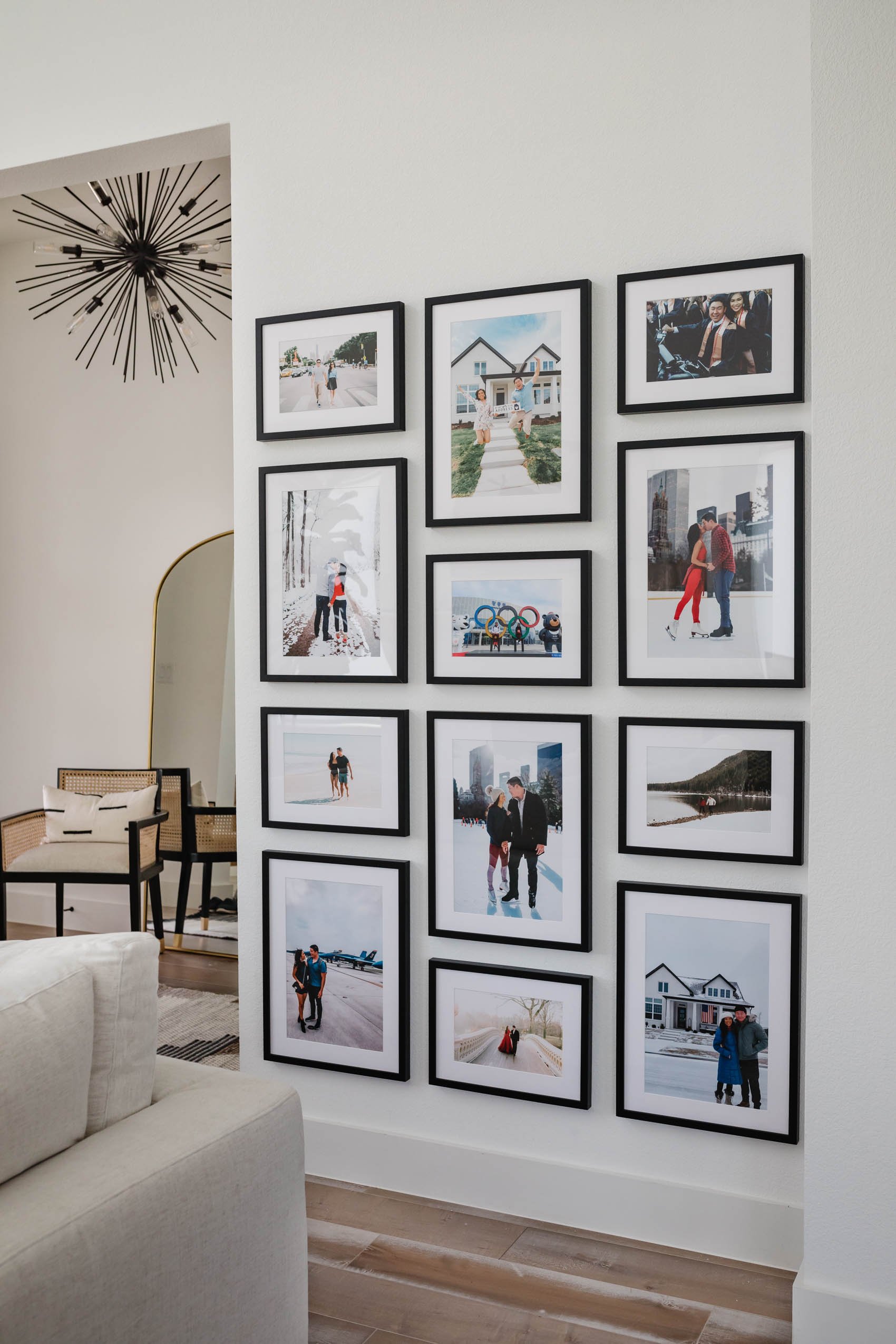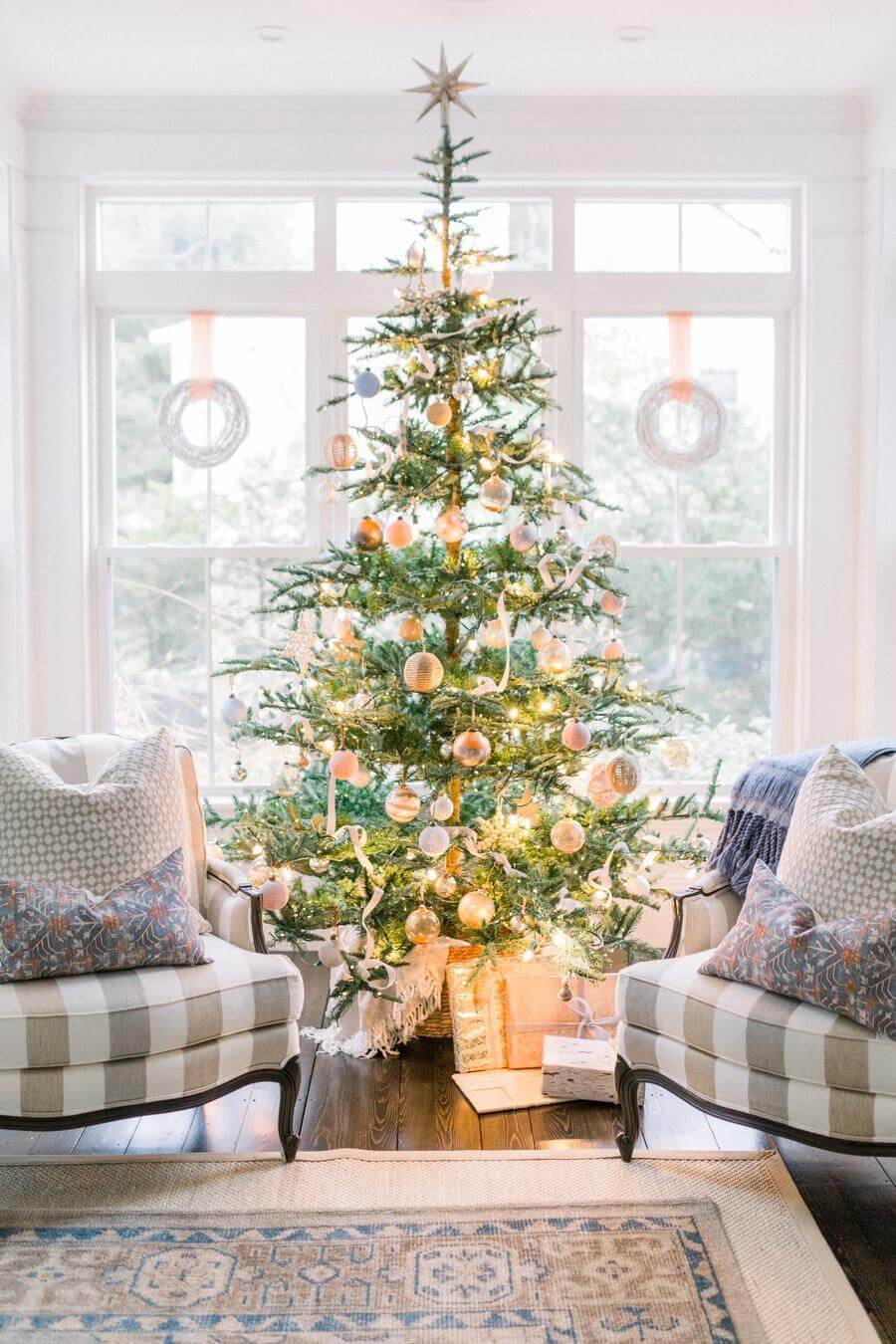How to Identify Your Interior Design Style in 4 Easy Steps
How to Find Your Interior Design Style: Part 2 of 2
Part Two
Dear Julie Ann,
We just moved into a new home, and I am really trying to find my interior design style.
How do you suggest people get started? - Neely
Dear Neely,
Thanks for this question! This is the second of a two-part answer to your question in the Ask Julie Ann series on the Blended Decor blog. In the first post, I covered five questions to help you find your signature look. In this post, I will explain what it means and why it’s important to have an interior design style, then I will give you four steps to find your style, as well as answer commonly asked questions. I hope this helps you to discover your unique style!
Part 1: Master Your Interior Design Style: Five Questions To Help You Find Your Signature Look
Part 2: How to Identify Your Interior Design Style in 4 Easy Steps <— You are here!
Topics:
You’ll also enjoy:
What is interior design style?
Interior design style is an overarching outlook on life and home that shows through every aspect of a space. It is a reflection of an individual's lifestyle and personal tastes. It encompasses the colors, textures, and materials used in home décor and furnishing, and helps define the ambiance of a space. Interior design styles can range from traditional and classical to more modern and contemporary, depending on a homeowner's preferences. Traditional styles are often characterized by dark walls, large furniture, and elegant lighting, while contemporary styles can feature brighter colors and more minimalistic décor. Ultimately, the goal of interior design is to create a space that is tailored to the individual's lifestyle and preferences.
Jump to:
Why is it important to have an interior design style?
1. A singular style helps to unify all of the elements in a home, creating a unified look.
Having an interior design style helps to unify all of the elements in a home, creating a harmonious look, by creating a consistent theme throughout. A defined style gives a focus to confidently pick out the right colors, pieces, and lighting for every room. Having one unified style for all of the elements of a home helps to make all the elements flow together, and creates a sense of harmony and purpose.
In addition, curating the home’s new style with only the pieces you love will add to the overall cohesion. Choosing pieces that fit the space while still embodying a consistent style helps to create a unified look. Moreover, considering the amount of light and the dimensions of rooms to find the right furniture that fits can also help to create a seamless and well-arranged space.
Furthermore, when selecting a style, it is important to think of practicality and functionality. Choosing pieces that you and your family will enjoy and use in the long run is key to creating a liveable and comfortable home. Being aware of your own tastes and style preferences will help to create a space that truly reflects you, and allows you to feel comfortable in your own home.
Having an interior design style helps to unify all of the elements in a home, creating a well-planned look. From choosing the right colors and pieces, to curating a style with only the pieces you love, to considering practicality and functionality, having an interior design style is essential for creating a unified and coordinated look.
French Country Style | via House Beautiful
2. A style helps people to identify a home’s aesthetic quickly, making it easy to recognize as well as welcoming.
Having an interior design style is beneficial to people because it allows them to create a home that reflects their personality and preferences. With a clearly defined style, you can make decisions on furniture, décor, and accessories that fit your style and create a put-together look. Additionally, having an interior design style can give you a sense of comfort and satisfaction in your home. When you take the time to choose pieces that speak to your personal style, you will feel as though your home is an extension of you, rather than just a collection of random items. By understanding and incorporating your interior style, you can create a home that is inviting, stylish, and uniquely yours. There are many ways a defined interior design style can make your home more welcoming. Here are a few examples:
A cohesive style creates a sense of order and calm. When all of the elements in a room work together, it creates a more inviting and relaxing space.
A well-defined style can make your home feel more personalized. When you choose a style that reflects your own unique taste, it creates a space that feels like your own.
A stylish home can make guests feel more comfortable and at ease. When you take the time to decorate your home in a way that is both stylish and inviting, it makes guests feel more welcome.
Here are some additional tips for making your home more welcoming:
Use warm colors and inviting textures. Warm colors, like red, orange, and yellow, are known to create a welcoming and inviting atmosphere. Textures, like velvet, suede, and fur, can also add a touch of warmth and comfort.
Add personal touches. Your home should be a reflection of your own unique personality. Add personal touches, like family photos, artwork, and souvenirs, to make your home feel more like your own.
Keep it clean and tidy. A clean and tidy home is always more welcoming than a cluttered one. Make sure to dust, vacuum, and mop regularly, and declutter any unnecessary items.
Light some candles. Candlelight can create a warm and inviting atmosphere. Light some candles in your living room or dining room to create a more relaxed and comfortable space.
Put on some music. Music can also help to create a more welcoming atmosphere. Put on some soft, instrumental music to create a relaxing and inviting space.
By following these tips, you can make your home more welcoming and inviting for guests and family alike.
3. A style helps to create a mood, which can help to relax, energize, or focus.
Having an interior design style helps to create a mood in your home by reflecting the personality of the individual and their lifestyle. It can shape the emotion of how you feel in your home, even subconsciously. Your style will determine what types of furniture and accessories you choose, as well as the colors and textures of the walls, floors, and ceilings. All of these factors work together to create a unique atmosphere that you can relax and enjoy. Having a defined interior design style can help to relax, energize, or focus in a number of ways. For example:
Color: The colors you choose for your home can have a big impact on your mood. For example, cool colors like blue and green can be calming and relaxing, while warm colors like red and orange can be energizing.
Light: The right lighting can also help to create a relaxing or energizing atmosphere. For example, soft, diffused light can be calming, while bright, direct light can be energizing.
Furnishings: The type of furniture you choose can also affect your mood. For example, soft, comfortable furniture can be relaxing, while sleek, modern furniture can be energizing.
Décor: The accessories you choose for your home can also help to create a relaxing or energizing atmosphere. For example, plants and flowers can be calming, while artwork and photos can be energizing.
By choosing the right colors, lighting, furnishings, and décor, you can create a home that is both stylish and conducive to your mood.
Here are some additional tips for creating a more calming or focused space in your home:
Choose colors that have a calming effect on you. If you find that certain colors make you feel more relaxed, use them in your home. For example, blue and green are often associated with relaxation.
Use soft, diffused lighting. This type of lighting can help to create a more calming atmosphere. You can use lamps, candles, or even natural light to create this type of lighting.
Choose comfortable furniture. When you're relaxing, you want to be able to sink into your furniture and feel comfortable. Choose furniture that is soft and supportive.
Add plants and flowers to your space. Plants and flowers can help to purify the air and create a more relaxing atmosphere.
Remove clutter from your space. Clutter can be overwhelming and distracting. Take some time to declutter your space so that you can focus on the things that are important to you.
Create a focal point in each room. This could be a fireplace, a piece of art, or even a plant. Having a focal point will help to draw your eye and create a more balanced space.
By following these tips, you can create a home that is both stylish and conducive to your mood. With the right design style, you can achieve a sense of comfort and security that makes your home feel like a haven from the outside world.
4. A style helps to create a well thought out aesthetic, which can make a space feel more expensive.
Having a defined interior design style can make your home look more expensive in a number of ways. For example:
It creates a sense of luxury. When all of the elements in your home are connected, it creates a sense of luxury and sophistication. This is because the eye is drawn to the overall look of the space, rather than individual pieces of furniture or décor.
It makes your home more timeless. When you choose a timeless style, your home will not look dated in a few years. This is because timeless styles are based on classic principles of design, rather than trends.
It makes your home more inviting. When your home is well-designed, it will make guests feel comfortable and at ease. This is because a well-designed space is one that is easy to move around in and that has a sense of order.
If you are looking to make your home look more expensive, consider choosing a defined interior design style. With a little planning, you can create a space that is both stylish and functional.
Here are some additional tips for making your home look more expensive:
Use high-quality materials. When you use high-quality materials in your home, it will make your space look more luxurious and expensive. This is because high-quality materials are often more durable and have a better finish.
Invest in classic pieces. Classic pieces of furniture and décor will never go out of style. This means that you can invest in these pieces knowing that they will last for many years to come.
Pay attention to the details. The details can make a big difference when it comes to the overall look of your home. This means paying attention to things like the paint color, the lighting, and the accessories.
Declutter. Clutter can make your home look smaller and less expensive. This means getting rid of anything that you don't use or need.
Keep it clean. A clean home is always more inviting than a dirty one. This means making sure that you dust, vacuum, and mop regularly.
By following these tips, you can make your home look more expensive without spending a fortune.
5. A style helps make your home more functional.
Having an interior design style can help people to navigate their home in a more systematic way. When you have a specific style in mind, you can make choices about furniture, décor, and even paint colors that will all work together to create a cohesive and functional space. For example, if you have a modern style, you might choose sleek, minimalist furniture and décor in neutral colors. This will create a clean and uncluttered space that is easy to move around in. On the other hand, if you have a traditional style, you might choose more ornate furniture and décor in rich colors. This will create a more cozy and inviting space that is perfect for relaxing or entertaining guests. if you have a family with young children, you might choose furniture that is durable and easy to clean. You might also choose décor that is child-friendly and won't break easily. Not only will this make their home more aesthetically pleasing, but it will also make it easier to shop for furniture, artwork, and other accessories. Additionally, considering lighting and measurements when choosing products in your style for the home can ensure that items fit and function well in the space.
6. A style can help people to know what will and won’t work in a home, saving time.
Having an interior design style can help people to know what will and won’t work in a home, saving time and energy when it comes to home decorating decisions. Knowing your design style narrows down your choices, so when shopping for furniture or accessories, you are able to find pieces that fit into your style quicker. Knowing your style also helps to eliminate the stress of indecision when shopping, as you have an idea of what you are looking for and what will fit with the rest of your decor. Additionally, having an interior design style allows you to curate your home's new style by only bringing in things that make you happy and that will last for the long run. Decorating with your own style will ensure that you feel comfortable and content in your home.
Key takeaways about saving time with a defined style:
You won't have to spend as much time making decisions. When you have a specific style in mind, you can quickly narrow down your choices when it comes to furniture, décor, and other home furnishings. This can save you a lot of time and energy.
You won't have to make as many changes. When you have a well-defined style, you're less likely to get bored with your home's décor and want to make a major change. This can save you time and money in the long run.
You'll be more organized. When all of the elements in your home are cohesive, it's easier to keep things tidy. This can save you time and stress in the long run.
Overall, having an interior design style can save you time in a number of ways. If you're looking for a way to simplify your life and make your home more functional, consider choosing a specific style.
Here are some additional tips for saving time when decorating your home:
Plan ahead. Take some time to think about your needs and wants before you start shopping. This will help you avoid impulse purchases and make the decorating process more efficient.
Create a budget. Setting a budget will help you stay on track and avoid overspending.
Shop around. Compare prices from different retailers before you make a purchase.
Use online resources. There are a number of websites and blogs that can provide you with inspiration and tips for decorating your home.
Don't be afraid to ask for help. If you're feeling overwhelmed, don't be afraid to ask a friend, family member, or professional for help.
7. A style can help people to know which designers or brands to trust.
Having an interior design style can help people to trust designers or brands by allowing them to shop with confidence and narrow their options to the items that fit their style. Knowing one's design style can help to identify what they like and don't like, and what they want and don't want in their home, thus giving them the focus they need to confidently pick out the right colors and pieces for every room. Having a style also helps to reduce feelings of indecision when shopping; it narrows down choices and makes it easier to find what one is looking for. Furthermore, having a style that reflects one’s personality and tastes helps to create a home that feels right and comfortable. By having a sense of their own interior design style, people are better able to interact with designers and brands in a more informed and confident way.
Key takeaways about how a defined style helps you to know which designers or brands to trust:
It can help you to narrow down their choices. When you know what style you like, it's easier to find designers or brands that specialize in that style.
It can help you to avoid making impulse purchases. When you know what you're looking for, you're less likely to be swayed by trends or sales.
It can help you to get the best possible results. When you work with a designer or brand that understands your style, you're more likely to get a space that you love.
Here are some additional tips for finding the right interior designer or brand:
Do your research. Read online reviews, look at portfolios, and ask around for recommendations.
Interview potential designers or brands. This is your chance to ask questions and get a feel for their style.
Trust your gut. If you don't feel comfortable with a designer or brand, don't work with them.
By following these tips, you can find the right interior designer or brand to help you create a space that you love.
8. A style can help people to know what resources to look for, making it easier to get started.
Having an interior design style can help people get started when decorating their home. Knowing your style can make it easier to identify what furniture, accessories and paint colours to choose for your home. It can also help you create a Pinterest board of rooms that you love and find inspiration from. Moreover, having a style can give you the necessary design vocabulary to narrow your search for the perfect home decor pieces. Plus, having a style can help you realistically appraise your space and decide if you need a total revamp or just a few accessories to showcase your style. Knowing your style makes it easier to create a home that truly reflects who you are.
For example, if you know that you like a modern style, you can look for resources that focus on modern design. This could include magazines, websites, or even interior design firms that specialize in modern design.
Having a defined style can also help you to narrow down your choices when it comes to furniture, décor, and other home furnishings. This is because you will know what colors, textures, and materials you like. This can save you time and money in the long run.
Additionally, having a defined style can help you to stay on track when it comes to decorating your home. This is because you will have a clear vision for what you want your home to look like. This can help you to avoid making impulse purchases and to create a space that you love.
Here are some additional tips for finding the right resources to help you get started with your interior design project:
Do your research. There are a number of resources available to help you learn about interior design. This includes books, magazines, websites, and even interior design firms.
Ask for help. If you are not sure where to start, ask for help from a friend, family member, or interior designer. They can help you to narrow down your choices and to find the resources that you need.
Don't be afraid to experiment. The best way to learn about interior design is to experiment. Try different things and see what you like. Don't be afraid to make mistakes. Everyone makes mistakes when they are learning something new.
By following these tips, you can find the resources you need to get started with your interior design project.
9. A style can help people to know what trends to expect in the design industry.
Having a personal style can help people to predict trends in interior design by giving them a better understanding of their own tastes and preferences. Knowing your style can help you to choose colors, materials, and furniture pieces that are already trending or will become popular in the future. It can also help you to make decisions about how to best use space and to create cohesive design across the room. Having a personal style can help you to see how certain elements come together and how certain trends may be interpreted in your home. This can make it easier to predict what colors, textures, and styles will become popular in the future and make sure that your home is always up to date. This is because trends often reflect the current zeitgeist, and people who are already aware of their own personal style are more likely to be attuned to the broader trends that are emerging. Trends often build on existing styles. For example, if you like a modern style, you will become attuned and know when you see trends that incorporate modern elements, such as clean lines, sleek furniture, and minimalist décor.
Knowing your style can also help you to avoid trends that you don't like. For example, if you don't like a traditional style, you can avoid trends that incorporate traditional elements, such as ornate furniture, heavy fabrics, and lots of décor.
Finally, knowing your style can help you to create a space that is both stylish and timeless. This is because timeless styles are based on classic principles of design, rather than trends. When you choose a timeless style, you can be sure that your home will not look dated in a few years.
Here are some additional tips for staying on top of interior design trends:
Read interior design magazines and websites. This is a great way to stay up-to-date on the latest trends.
Follow interior designers on social media. This is a great way to see how trends are being used in real homes.
Visit furniture and home décor stores. This is a great way to see the latest trends in person.
Attend interior design shows. This is a great way to see the latest trends from a variety of designers.
Of course, it's important to remember that trends are just that: trends. They come and go, and it's not always necessary to follow them. If you find a style that you love, stick with it even if it's not currently trendy. After all, style is timeless, and what matters most is that you create a space that you love.
10. A style can help people to know what to expect in a budget, making it easier to plan.
Having an interior design style can help people to know what to expect in a budget because it narrows down the choices when shopping for items, meaning less impulse buying and more budgeting. Knowing what you want and what you don’t want in your home before you shop can prevent decorating paralysis, and makes it easier to stick to a budget. Reusing items you already have and shopping at garage sales, estate sales, and secondhand stores can also help you stay within your budget. Mixing and matching elements, as well as trying your hand at DIY-ing pieces, are also great ways to decorate on a budget without sacrificing your dream home decor. When you know what style you like, you can start to research the costs of different materials, furniture, and décor. This can help you to create a budget that is realistic and that will allow you to achieve your desired look.
For example, if you are interested in a modern style, you will likely need to invest in high-quality materials, such as stainless steel and glass. This can be more expensive than traditional materials, such as wood and fabric. However, the investment is worth it if you want a space that is both stylish and timeless.
On the other hand, if you are interested in a traditional style, you may be able to find more affordable options. This is because traditional styles often use more traditional materials, such as wood and fabric. These materials are often less expensive than high-end materials, such as stainless steel and glass.
Finally, knowing your style can help you to make informed decisions about your budget. For example, if you are on a tight budget, you may want to consider choosing a style that is less expensive. This does not mean that you have to sacrifice style, but it does mean that you may need to be more creative with your choices.
How to uncover your interior design style?
Step 1: Know how you want your room to feel
Take some time to reflect on how you want your home to feel. Take a walk, sit in your favorite spot in your home, or even try having a conversation about it with someone who is involved in the decorating process.
Think of words that encapsulate the feeling you want your home to have. Examples could include ‘cozy,’ ‘relaxing,’ ‘restful,’ ‘peaceful,’ ‘fresh,’ ‘clean,’ ‘inviting,’ ‘airy,’ or ‘elegant.’
Take note of the items you already have in your home. Look around and see what furniture, accessories, and paint colors you already have and if they make you happy.
Create a Pinterest or Houzz board of rooms you love. Scroll through the Home Decor section for images that resonate with you and add them to your board.
Study both what you have and what you want and match it up with a style. Make a list of all the distinct features you notice in the furniture, accessories, fabrics and paint colors.
Step 2: Create a Moodboard on Pinterest
Pinterest can be a great tool to help uncover your interior design style. When you search for specific keywords, such as “cozy dining room” or “traditional navy dining room”, you can start to find images that convey the feelings you’re going for. You can save these images to a Pinterest board and start to look for commonalities among them, such as what colors keep popping up, shapes or styles of furniture, or decor elements like plants or wall art. By pruning out images that don't fit and deleting outliers, you can refine the board until there’s a clear answer that speaks to your personality and style. Taking the time to properly use Pinterest in this way can help you uncover your interior design style.
Step 3: Study your favorite inspirations
Studying your refined inspirations can help you uncover your interior design style by taking note of what you already have in your home, creating a Pinterest board of rooms you love, and studying both what you have and what you want and matching it up with a style. By taking the time to observe the results from your searches and asking questions about what draws you to certain images, you'll be able to note reoccurring elements like furniture styles, colours, paint colours and fabric styles in the photos. You can then make a list of all of the distinct features you see and match it up to 1, 2 or 3 of the 10 common decor styles, helping you to uncover your interior design style.
Collected Loft Style | Pinterest Board Screenshot
Step 4: Consult with a professional interior designer
Consulting with a professional interior designer can help you uncover your design style by guiding you through the often confusing process of putting together a room. A designer can provide you with the tools and knowledge to make informed decisions and craft a room that reflects your needs and preferences. Through a series of questions, a professional designer can help you assess what colors, materials, and furniture will best suit the space and create a room that's tailored to your taste. Additionally, they can offer guidance on which pieces to splurge on and which can be purchased on a budget. Ultimately, they will help you create a room that's uniquely yours, without spending a fortune in the process.
People Also Ask
I’m so overwhelmed with all of the various interior design styles! What do I do now?
Take a deep breath and embrace the slow decorating trend. Slow decorating is an eco-conscious, mindful approach to home decorating that encourages investing in quality pieces, embracing a timeless style, and utilizing sustainable and eco-friendly materials and processes. The process eliminates pressure, allows time for budgeting, and can help create a trend-proof style. Slow decorating is similar to the slow fashion movement: it's about quality over quantity, focused on purchasing high-quality products leads to less waste and fewer replacements. "According to New York-based interior designer Amy Baratta, slow decorating recognizes that style and spaces evolve over time, so it encourages homeowners to invest in pieces they'll want to keep and continue to use.
Slow decorating is a sustainable home trend that takes time and intention. It's about buying quality items that will last and appreciating things with an eye for timeless style. With slow decorating, you don't have to worry about having things finished quickly or having a single style. It also helps create an eco-friendly home with fewer disposable items. When you take time to decorate your home, you can develop and understand your personal style and feel more confident in the end.
Key takeaways:
1. Slow decorating is an eco-conscious approach to home decorating that encourages investing in quality and sustainable pieces.
2. It eliminates pressure and allows time for budgeting.
3. It encourages creating a trend-proof style.
You may also wish to take an interior design style quiz to see if it resonates with you.
Slow Living Decorating Style | Ellei Home
What is an interior design style quiz?
An interior design style quiz is a great way to get an idea of what type of aesthetic you’re drawn to. It’s a quick and easy questionnaire that asks you about your preferences for different pieces of furniture, colors, materials, and other decorative elements. By selecting your favorite items, you can discover which design style best reflects your individual style. This can be especially helpful if you’re not sure which direction to take when decorating your home. It provides you with the opportunity to explore different elements of design and narrow down your choices—allowing you to create a space that you love. With interior design quizzes like the ones offered by the Designer Society of America and Apartment Therapy, you can quickly and easily find out which interior design style best suits your tastes.
My Favorite Design Quizzes: * = most accurate for me
Pottery Barn Style Finder
What are some of the most popular interior design styles?
The geographic area that you live in may prefer a certain design style. Overall, the most popular interior design styles right now are:
Mid-Century Modern: MCM incorporates elements from the mid-20th century such as clean lines and organic shapes.
Rustic Farmhouse: Rustic Farmhouse style is a design aesthetic that evokes the simplicity and charm of a country home
Eclectic Bohemian. Bohemian style combines bold colors, patterns, and textures to create an eclectic and inviting atmosphere. Eclectic means that additional styles are blended in as well.
Additional popular styles include traditional, transitional, contemporary, modern farmhouse, modern coastal, industrial, French country, and Scandinavian.
Traditional style includes dark walls, large furniture, and elegant lighting, and it tends to give a room a sense of grandeur and old-world elegance.
Transitional style combines traditional and modern elements to create an updated look.
Contemporary style is clean and modern, with minimalistic and streamlined designs.
Modern farmhouse style combines rustic elements with modern touches to create a cozy and inviting living space.
Modern coastal style blends contemporary and beachy vibes to create a light and airy atmosphere.
Industrial style consists of metal, wood, and leather elements along with exposed pipes and ductwork.
French Country style is a combination of rustic and elegant elements that exude a romantic and cozy vibe.
Lastly, Scandinavian style is characterized by light colors, natural materials, and minimalist designs.
COMMON DESIGN STYLES
Traditional Interior Design Styles
Blended Interior Design Styles
Boho Victorian (Boho + Victorian)
Eclectic (Mix of many styles)
Japandi (Japanese Zen + Scandinavian)
Maximalism (Eclectic + More Is More reaction to modern)
Modern Coastal (Modern + Coastal)
Modern Mediterranean (Modern + Minimalism + Mediterranean)
Preppy Palm Beach Glam (Preppy + Palm Beach + Glam)
Rustic Coastal (Rustic + Coastal)
Transitional (Classic + Traditional + Modern)
Vintage New Orleans (Vintage + French + Southern + Creole)
Urban Rocker Chic (Urban + Rocker Chic + Glam)
Contemporary Interior Design Styles
What are the main elements of interior design?
What are the main elements of interior design? The main elements of interior design include
color,
pattern,
texture,
lighting,
furniture,
accessories, and
architectural elements such as moulding and built-ins.
Color creates an atmosphere and mood in the room, and can be used to create different effects depending on how it is applied. Patterns can be used to add visual interest to the room and bring it to life, while textures can be used to add depth and warmth. Lighting can set the tone and ambiance in the room, while furniture should be chosen with comfort and functionality in mind. Accessories should be used to further personalize the space, while architectural elements like moulding and built-ins can provide a sense of grandeur and traditional appeal.
What are some of the current design trends?
Note: Design trends tend to have a 20-year life cycle.
Aesthetic Bedrooms (Tiktok-inspired)
Barbiecore (check out subtle ways to incorporate Barbiecore)
Global (read more above)
Hipstoric Home Aesthetic
Home Office (My articles about home offices can be read here)
Old-Money Aesthetic
Vanilla Girl (scandinavian + minimalism + japandi)
What are some of the current color trends?
What factors should I consider when decorating?
When decorating your home, there are a few important factors to consider. First, choose style elements and accessories that you and your family will enjoy and use in the long run. Also consider the amount of light your space gets, and choose paint colors and lighting that can brighten your space. Take notes about the dimensions of your room to make sure that you find furniture that fits. Additionally, curate your home's style by only bringing in things that make you happy, and take it easy on the accessorizing.
Then, take note of what furniture, accessories and paint colors you have, and create a Pinterest board of rooms you love. Use the items you already have in your home and your Pinterest photo collection as a reference, and make a list of all of the distinct features you see in the furniture, accessories, fabrics and paint colours. Match it up to 1, 2 or 3 of the 10 common decor styles to find what home style (or styles!) you are.
What materials are used in interior design?
Interior design materials can vary depending on the specific style you're aiming for.
For traditional interior design style, often you’ll see natural materials such as
wood,
stone,
marble, and
plaster.
These materials can create a grand and elegant look, while also adding a sense of warmth to the room. For the Asian-inspired interior design style, natural materials like bamboo and rattan are often used to create a more tranquil and calming atmosphere. These materials are lightweight and add an interesting texture and dimension to the space. In contrast, modern interior design often uses sleek materials such as metal, glass, and leather. These materials add a modern and contemporary feel to a room, while also creating a more luxurious and sophisticated look.
Would you like help bringing your design together?
I would love to collaborate and customize a design for your home. Contact me to schedule a chat!

